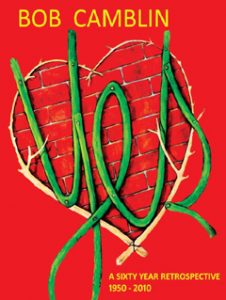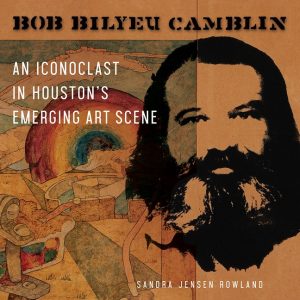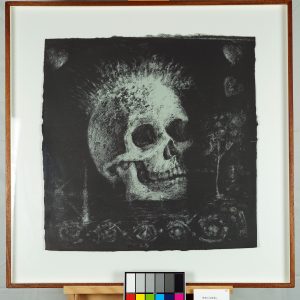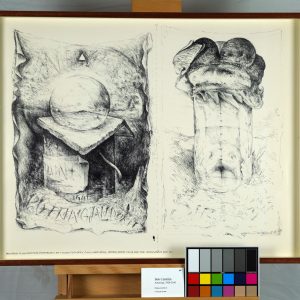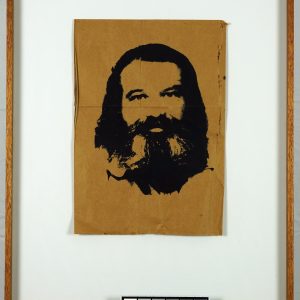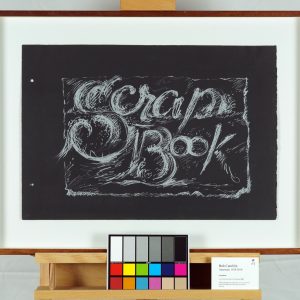Description
Nun, c. 1940s – 50sLithograph 9/10
Signed
9.5 x 8.5 in. (image)
23.75 x 18.5 x 2 in. (frame)
original, includes certificate of authenticity from ArtTrust
The drawing “Nun” displays a nun clad in a large, flowing habit, which creates a striking visual contrast due to its dark color against the lighter background. Her exaggerated headwear and the wide-brimmed veil give her an imposing presence. Two children are depicted; one appears in the foreground, looking up at the nun, while the other is partially hidden behind her robes, only visible from the shoulders up. The scene features a wrought-iron fence in the background, evoking a somber or institutional atmosphere. The composition has a graphic quality, with strong contrasts between black and white, emphasizing the figures and their expressions.
From a Zen perspective, the nun could symbolize the concept of “mu,” or nothingness, where the dark robes and minimalist rendering evoke a sense of emptiness and contemplation. The large, almost overwhelming habit can be seen as a metaphor for the spiritual path that covers the truth of one’s original nature, which one must seek to uncover. The children may represent the beginner’s mind—full of curiosity and uncertainty—seeking understanding within the shadows of tradition and institutional teachings.
An interpretation through the I Ching could involve Hexagram 4, “Meng” (Youthful Folly), which deals with learning and guidance. The children look towards the nun, possibly seeking knowledge or discipline, which aligns with the hexagram’s message of finding a teacher or guide. The hidden child might symbolize the aspect of youthful ignorance that is not yet ready to fully engage with the lessons being offered, while the child in the foreground is beginning to engage in seeking wisdom.
Integrating these interpretations, the image can be viewed as an exploration of the dualities in spiritual teachings—between the authority figure and the seekers, the known and the unknown. The nun’s large, enveloping habit suggests that the path to spiritual understanding is often shrouded, with layers to peel away before one reaches true insight. The children represent different stages of engagement with this path: one is stepping forward, while the other remains hesitant. It captures the dynamic between openness and concealment in the quest for spiritual knowledge.
The artwork’s style appears to draw from 20th-century graphic art, particularly reminiscent of German Expressionism, with its use of stark contrasts and exaggerated forms. The geometric treatment of the nun’s habit might also show the influence of Cubism. The choice of religious imagery, combined with the emotionally evocative style, recalls Käthe Kollwitz’s work, which often dealt with themes of suffering and social critique. The somber mood, combined with the depiction of innocence in the children, could also suggest influences from artists like Georges Rouault, who often explored religious themes with a modernist approach.
*Shipping cost will vary, please inquire at sales@camblingallery.com before purchasing.
Currently ships from Oregon, USA
Member of artnet? Apply for a discount! Inquire about intergallery and permanent loans for museums.
“Nun” was featured in his Yes Retrospective and in Sandra Jensen Rowland’s monograph, Bob Bilyeu Camblin – An Iconoclast in Houston’s Emerging Art Scene.
Reproductions of this drawing are available in multiple sizes!
Click here to use our high-resolution viewer!
This artwork is available with a non-fungible token to ensure traceability and transparency of provenance.
The royalty factor – Unlike traditional artworks, such as paintings, mosaics, statues, and the like, NFTs can be programmed to provide royalties to you every time the painting (and token) is sold and resold – for eternity. That mind-bending Camblin you sold could be worth millions one day and provide income for your great-great-great grandkids!
Anti-forgery – The central idea underpinning NFTs is that they are built on the blockchain, which is meant to offer advanced security. Think of it like an un-erasable and un-avoidable copyright.
Easy authentication – Another compelling aspect of NFT art and NFTs in general is the ability to quickly and easily authenticate items, as the record of ownership is scrupulously kept on the blockchain.

